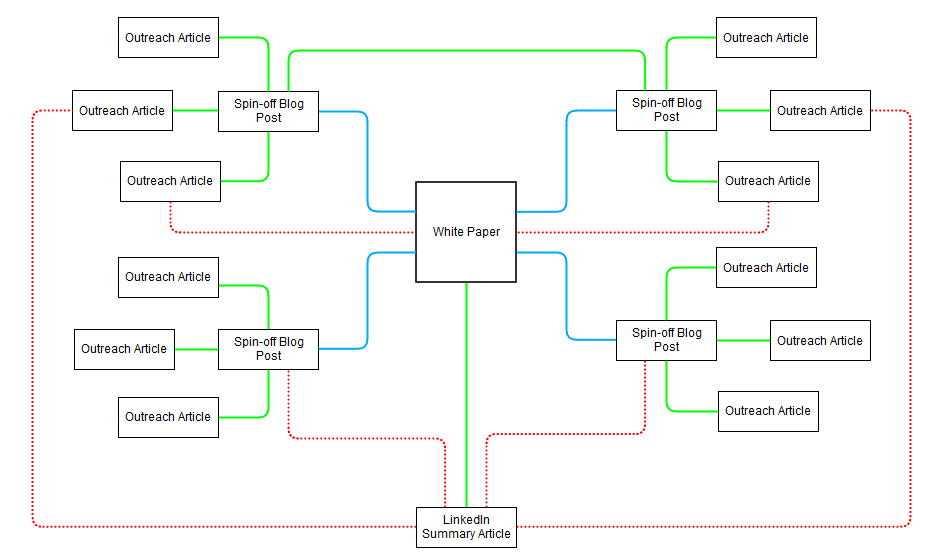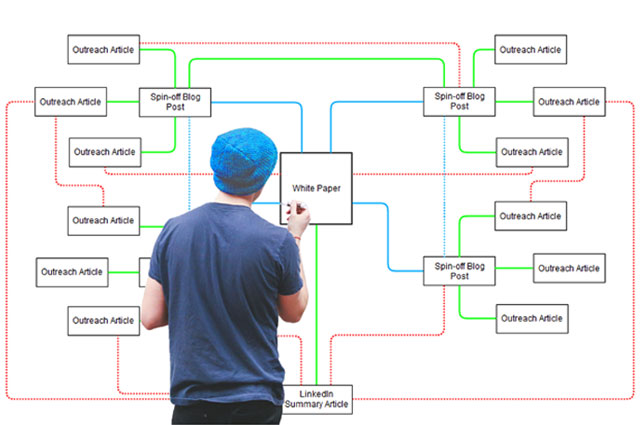Website Content Hierarchies
The cornerstone of any successful content marketing strategy is maximising your output with minimal effort. You might have heard the term ‘sweating your content’ before and despite the unfortunate images this may conjure up, it’s not a bad analogy. Essentially, the idea behind planning an effective content hierarchy is to make your content structure work as hard as possible, getting the most out of one core message to amplify it far and wide, ‘sweating’ it until you’ve achieved your goals. But what do you need to do in order to achieve this?
The answer lies in creating a website content hierarchy that pushes your core messaging to the very top, allowing both search engines and your target audience to easily locate and identify the content that matters most. The goal is to get users to the pages that best demonstrate your messaging, utilising supporting content and outreach posts to lead them there.
So, with that in mind, here’s our guide to creating an SEO content hierarchy that is guaranteed to put you top of the pecking order.
What is a Content Hierarchy?
A content hierarchy refers to the way your pages are structured, and how they link together. For example, at the centre of the hierarchy, you may want to focus on a particular blog post or guide, perhaps an in-depth piece about a certain topic. This will act as your content pillar. From here, you can expand outwards, linking and referring other pieces of content back to your main pillar. This may take place from content nodes within your website, but it is important to also consider external links and off-site sources that can be included.
There are several benefits to creating interlinked hierarchies of content, with one ‘hero’ piece acting as a focal point that breaks off into smaller, more focused pieces or content blocks. This approach helps your website visitors navigate to closely-related material, while also improving your search visibility – the more quality focused content you have, the greater chance you have of ranking for specific search queries. Other benefits include extending your reach on social media, not to mention giving you material for publishing opportunities on third-party websites.
Planning Strategic Content Hierarchies
The aim of SEO focused content hierarchies is to create a web of rich content that complements every other hierarchy node, like a family tree that branches off into different directions but can easily be traced back to where it all began, giving both users and search engine bots a clear roadmap of your website.
Content may be king, but context is certainly queen, so firstly you need to consider what type of content you want to produce and what purpose it is there to serve. For example, as a content marketing agency, we might plan to publish a white paper on content marketing strategies. Hopefully our target audience will find this useful, and it will showcase our expertise in such a way that others might reference our report, earning backlinks and boosting SERP visibility, while also potentially encouraging prospective clients to get in touch.
Thus, the white paper (or WP) will be the ‘hero’ content, the pillar or hub of our hierarchy. From here, we can create a series of blog posts, focused on different points raised within the WP, drilling into specific arguments or exploring individual stats. These pieces of cluster or satellite content will naturally all link back to the cornerstone piece, as well as most likely referencing each other. The bones of the on page content hierarchy for SEO is starting to form.
We can then write an article for publication on LinkedIn, summarising the key findings of the WP and presenting them in an abridged format, more suited for consumption on the social network. Furthermore, we’ll conduct some prospecting and influencer outreach. This could result in contributing guest articles on related websites with large audiences, or gaining backlinks in articles which will reference both the WP and the secondary blog posts published on our own site. This will help us expand our hierarchy framework from our own site to external sources.
In very basic terms we’ll land up with a web of content that looks a bit like this

By interlinking intelligently within these articles, we’ll very quickly build up a large collection of content all focused on a specific theme or keyphrase – in this visual hierarchy, our keyphrase is “content marketing strategy”. This will send the right signals to Google, ensuring we naturally begin to rank highly for our target phrase, helping potential customers find our website and, hopefully, enlist our services.
Every time you link to a web page, even those on your own site, you boost its authority, especially if using keyword-rich (but not spammy) anchor text. In layman’s terms, search engine bots regard hyperlinks as signals of relevance, so every time you link to a page you’re effectively ‘voting’ for it, giving it a boost in the rankings for that relevant search term.
Thus, in this example, our white paper is receiving several first-hand links, but also several secondary links, vastly increasing its authority as the ‘link juice’ flows through the web.
Additionally, when we link to an outreach article from our blog, and vice-versa, we’re giving each page a ‘vote’, helping to boost their presence in search results, aiding our cause even further. This may be only a marginal gain on an individual basis, but when done routinely this game plan can pay dividends. You can keep track of links to your site by utilising Google Search Console.
This type of linking also gives Google further signals; it looks at the content of the pages that have been linked to, and if there’s semantic relevance between them, it will further boost your authority. As such, you shouldn’t link to a page that is irrelevant to your content, because Google may mistake the intended purpose and remove some of your perceived relevance.
Similarly, Google will look at the other pages on the site you’re linking to or receiving links from, even if you’re not linking to them directly. That is to say, obtaining a link from a site that’s wholly dedicated to content marketing will carry much more SEO weight, rather than a link from a site that has one page on content marketing, one on health and another on film reviews, or very little about content strategy at all. It may be worth analysing the content on the sites you hope to obtain a backlink from, or checking their own Domain Authority, to try and determine how impactful a link will be for your website.
Structuring Content Hierarchies
Below is a breakdown of how we might map out a strong content hierarchy for our target phrase.
Target Keyword: Content Marketing Strategy
- White Paper: What makes a great content marketing strategy?
- Blog: Why your businesses needs a content marketing strategy
- Outreach: Content marketing strategy for startups
- Outreach: B2B content marketing strategy. What is important in 2017?
- Outreach: How to plan a small business content marketing strategy
- Blog: Why strategy is so important in your content marketing efforts
- Outreach: 5 key elements of a content marketing campaign
- Outreach: Setting goals for your content marketing and outreach activity
- Outreach: Getting ROI from your content marketing
- Blog: How to plan a content marketing strategy
- Outreach: Planning a content marketing strategy that delivers
- Outreach: Putting your content marketing plan into action
- Outreach: How to build flexibility into your content marketing strategy
- LinkedIn: Building an effective content marketing strategy that delivers ROI
The key advantage of this approach is that you only have to do the hard research once, when you’re producing the white paper. The additional content will be a development and repurposing of existing data and ideas. Yes, you have to give it a unique twist every time (Google will penalise you if you litter the Web with duplicate content), but you don’t have to reinvent the wheel.
Needless to say, you don’t have to follow the above idea, and this is not the only form of content hierarchy. We are doing something similar with Guides and related chapters on our blog. This works on a more traditional hierarchy format, but again we can spin off a series of blogs from every guide, or indeed chapter, helping to easily create more content from one central idea. As an example, our own structure looks a little like this:
- Guide: Content Marketing
- Chapter: How to create eye-catching headlines
- Chapter: Why outreach is an essential part of your content marketing activity
- Chapter: How to write an outreach email
- Chapter: Top tips for researching the best publishing sites
- Chapter: Getting the balance right: What is the perfect content marketing mix
- Chapter: The differences between Native Advertising and Content Marketing
Having this framework in place ensures that, not only is our content calendar clearly defined with a smooth pathway between each piece, but we’re also acutely aware of the keywords and phrases we’re targeting as part of our overall strategy, laying the foundations for effective digital copywriting.
Ultimately, relevance is the key to success, and that’s the word you have to bear in mind when forming your content plan. Be sure that every proposed piece of content is relevant to your audience, and then look for natural ways of linking it to your complementary material.
Highly-Focused Content Marketing
Your output should not be limited to written content, as multiple mediums can form part of the perfect content marketing mix. Perhaps you could conduct a survey and write your findings up in the white paper, but also visualise some of the data in an infographic.
You could also host a Facebook Live broadcast discussing the contents of your white paper, inviting people to download it and answering questions as they come pouring in from your fanbase. Another option is to use the white paper as the basis of a webinar, taking people through your report page-by-page. A recording of the webinar can then be uploaded to YouTube, while your slides can be made available to download from SlideShare.
This gives you a wealth of content to ‘sweat’ on social, and obviously does wonders for your keyword relevancy. I can’t stress this enough, and I find many content marketers fail at this hurdle, but a huge part of your strategy should be determining the keyword focus of your content at the outset, so you can make sure each piece answers a specific question related to a core group of key phrases.
Always consider: Why are you creating this content? Is this content going to be useful to my target audience? How does one piece relate to another? How can I ‘sweat’ this till I cross the finish line?
Get Support
If you’d like some guidance on creating a content hierarchy structure that is guaranteed to get you noticed, why not reach out to our experts? We can help you plan, create, and execute a hierarchy designed to push your content to the forefront and boost your conversion rate.
Related Topics:
If you have any comments or questions about this post, or would like to discuss a specific issue with your site, please get in touch using the form below.
And connect with us on social media to stay upto date with our latest news:

